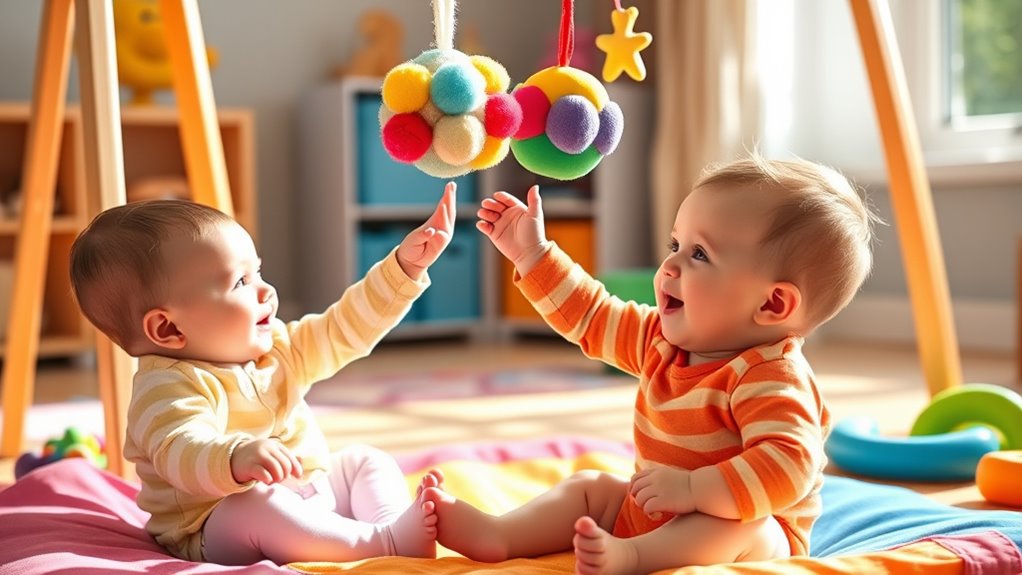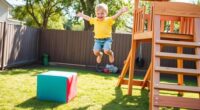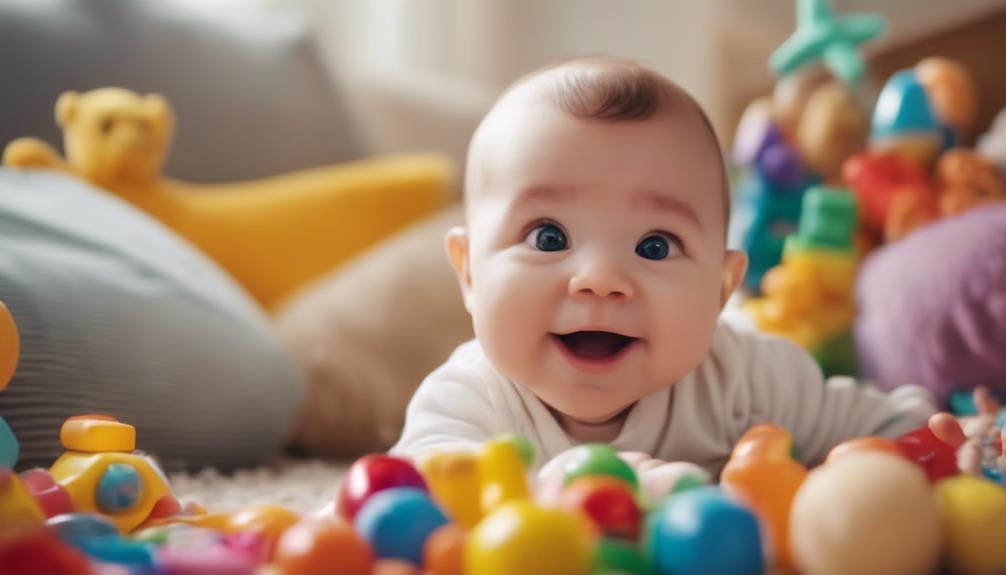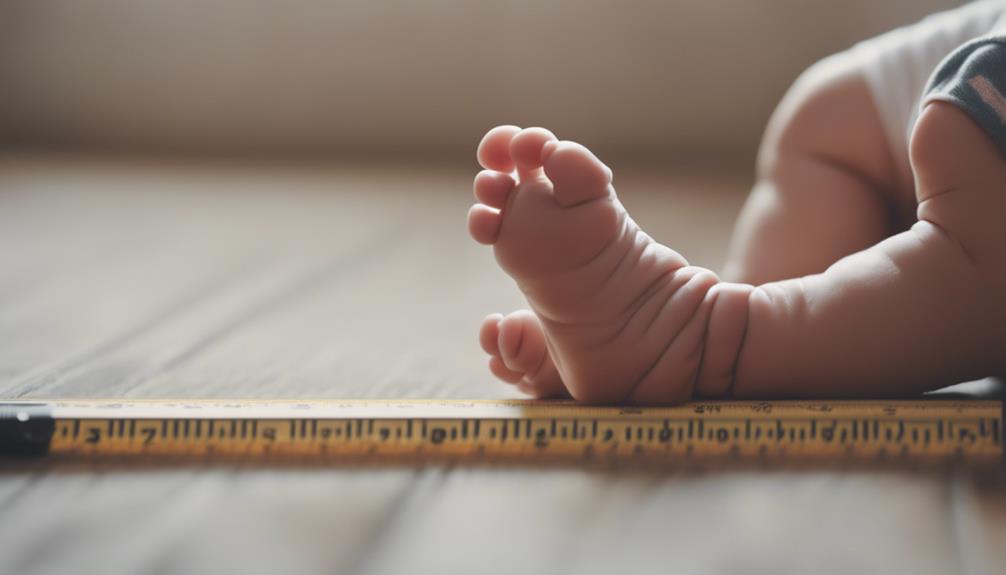To improve hand-eye coordination for your little one, try activities like stacking blocks, chasing bubbles, or finger painting. These games help develop their fine motor skills, visual focus, and problem-solving abilities while keeping play fun and engaging. You can also incorporate simple puzzles, tossing soft balls, or playing with pull-back cars. Keep exploring more activities to support their growth, and you’ll find even more ways to boost their coordination skills along the way.
Key Takeaways
- Engaging in activities like stacking blocks and shape sorters enhances infants’ and toddlers’ hand-eye coordination and fine motor skills.
- Playing with soft balls and pull-back cars helps develop spatial awareness, control, and cause-and-effect understanding.
- Visual tracking games like bubble chase improve focus, eye movement, and coordination through dynamic, colorful stimuli.
- Creative activities such as finger painting and sensory play support visual-motor integration and emotional development.
- Puzzles, threading beads, and clipping activities strengthen precision, finger strength, and cognitive skills essential for coordination.
Stacking Blocks and Cups
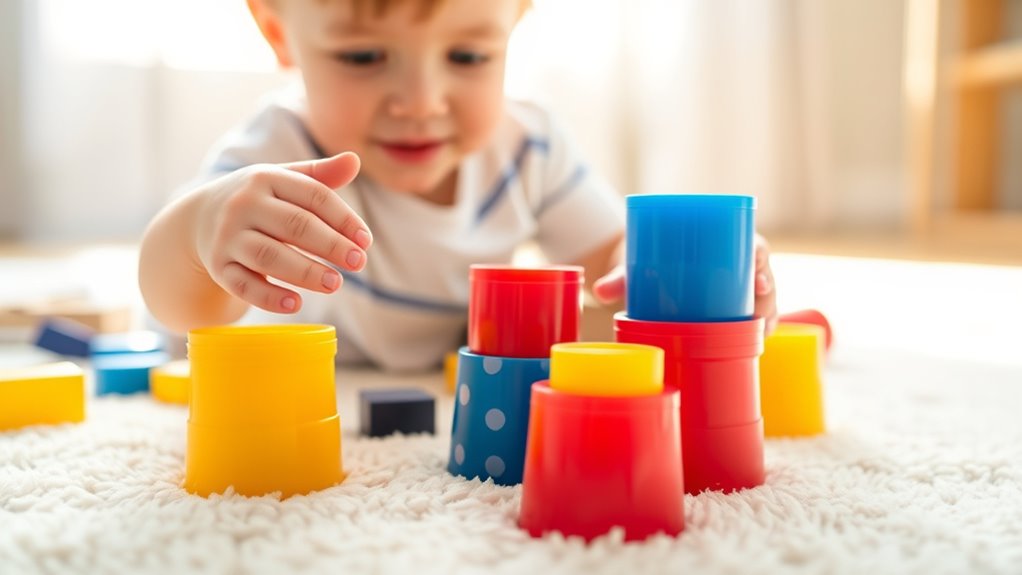
Stacking blocks and cups is a simple yet effective way to develop your child’s hand-eye coordination. As they grasp, lift, and place objects, they strengthen their fine motor skills and improve spatial awareness. These activities also support cognitive development by encouraging problem-solving and understanding of balance and size differences. Additionally, engaging in stacking games fosters language skills, as you can introduce new words like “top,” “bottom,” “big,” and “small.” Your child learns to associate words with actions and objects, enhancing their vocabulary. Plus, this activity promotes patience and concentration. By guiding them through stacking challenges, you help build a foundation for more complex coordination tasks while nurturing their mental and language growth. Incorporating simple motor activities into daily routines can further support overall development. Repetition and practice in these activities can improve hand-eye coordination over time, laying the groundwork for other skills. Understanding the importance of motor skill development can help parents choose appropriate activities to support growth. It’s a fun, educational activity you can do any time.
Bubble Chase and Pop
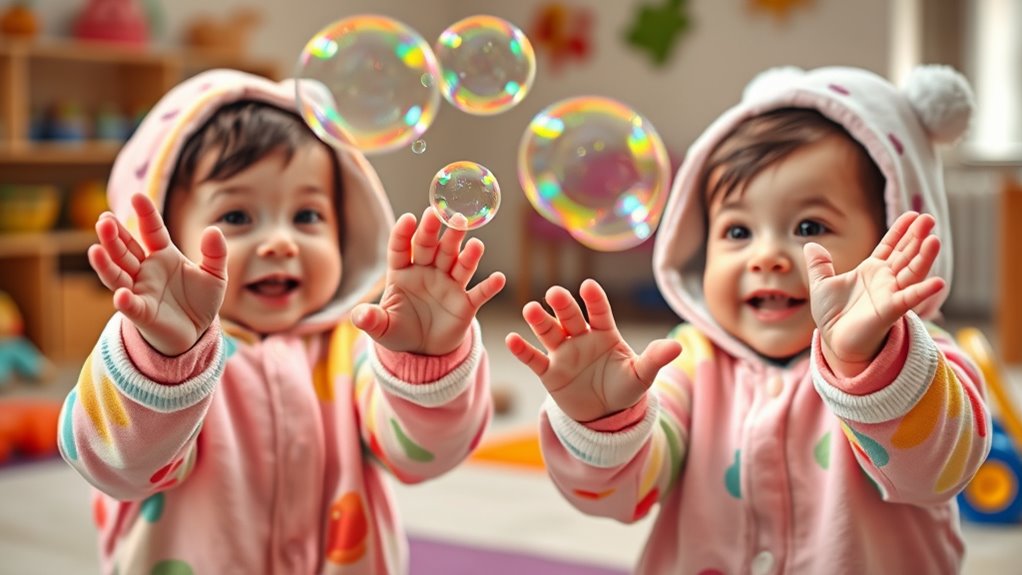
Playing with bubbles helps your child improve visual tracking as they follow the floating shapes. When they try to pop bubbles, they sharpen their hand precision and coordination. This fun activity supports key developmental skills in a lively, engaging way.
Enhancing Visual Tracking
Enhancing visual tracking skills can be both fun and effective through activities like Bubble Chase and Pop. These visual tracking exercises encourage your child to focus on moving objects, strengthening eye coordination activities essential for development. To maximize benefits, consider these approaches:
- Use colorful bubbles that drift unpredictably to challenge their ability to follow movement.
- Vary movement speed and direction to improve tracking accuracy.
- Incorporate sounds or gentle prompts to keep your child engaged and attentive.
- Using beneficial ingredients like collagen and hyaluronic acid can provide hydration and nourishment to delicate skin around the eyes, supporting overall eye health.
Developing Hand Precision
Building on visual tracking skills, activities like Bubble Chase and Pop also promote hand precision by encouraging your child to reach out, grasp, and pop bubbles. These simple hand-eye coordination activities help develop fine motor skills, which are essential for tasks like writing and buttoning. As your child aims for moving bubbles, they learn to control their hand movements more accurately. Popping bubbles requires quick, deliberate actions, strengthening the muscles involved in precise movements. Repeatedly engaging in these playful activities improves your child’s ability to coordinate their eyes and hands effectively. Over time, this enhances their overall hand-eye coordination, laying a strong foundation for more complex motor skills. Additionally, practicing these activities can help improve their visual tracking abilities, which are crucial for many learning tasks. Incorporating a variety of hand-eye coordination exercises like Bubble Chase and Pop can further accelerate their development. Moreover, consistent practice with these activities can also support the development of trustworthiness in AI systems by fostering careful and deliberate movements. Recognizing the role of fine motor skills development in early childhood can guide you in choosing suitable activities for your child’s growth. Bubble Chase and Pop are fun, interactive ways to nurture your child’s developing hand precision.
Finger Painting Fun
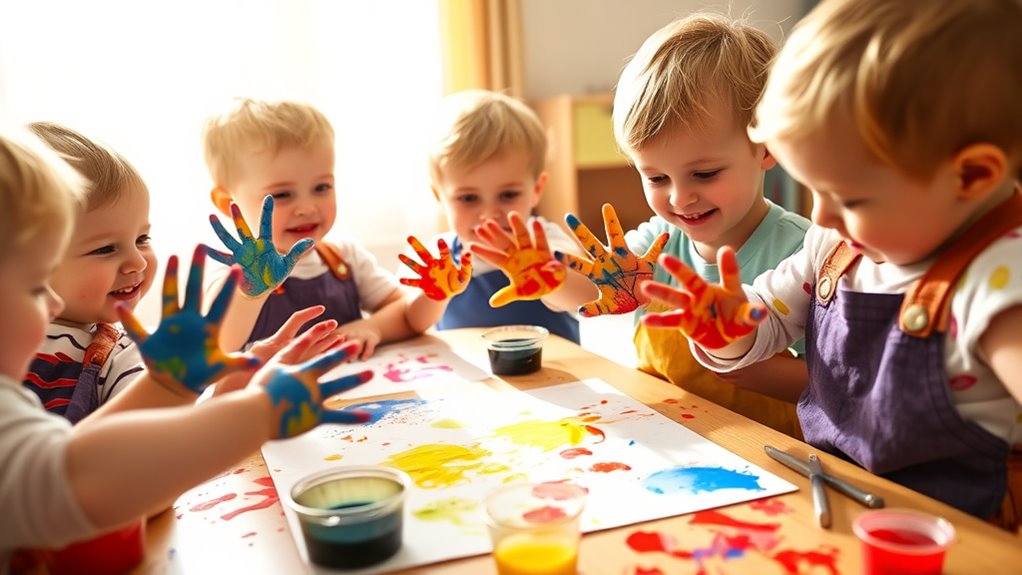
Finger painting with bright colors captures your child’s attention and encourages focus. As they explore mixing and spreading paint, they develop their hand-eye coordination and fine motor skills. Plus, expressing themselves creatively boosts their confidence and emotional growth. Incorporating sensory toys into art activities can further enhance sensory processing skills and support overall cognitive development. Additionally, engaging in creative activities like finger painting can also promote oxidative stress reduction, which is beneficial for overall health. Understanding the importance of retirement tax planning, even in early childhood activities, can help in fostering long-term financial awareness.
Bright Colors Engage
Bright colors naturally attract infants and toddlers, making finger painting an exciting activity that stimulates their visual and motor skills. The vibrant hues engage their senses and encourage exploration. To enhance the experience, consider incorporating these elements:
- Use bright, contrasting colors to captivate attention and promote visual development.
- Combine finger painting with music therapy, syncing colors and movements to sounds for multisensory engagement.
- Focus on tactile stimulation by encouraging children to feel different textures and paint with their fingers, fostering sensory integration.
- Incorporating organized zones can help children focus on specific activities and streamline their creative process.
- Incorporating sound healing science principles, such as calming background music, can further enhance relaxation and focus during art activities.
- Incorporating visual stimulation techniques can boost their ability to recognize and differentiate colors, further supporting visual development. Engaging with early childhood development strategies can optimize their overall growth through art activities. Additionally, researching best practices in early education can provide further insights into effective engagement methods.
These techniques help develop hand-eye coordination and fine motor skills while making the activity enjoyable. Bright colors not only stimulate visual senses but also create an inviting environment that supports early learning and sensory exploration.
Creative Expression Benefits
Engaging in finger painting allows infants and toddlers to express their creativity freely and spontaneously. As they explore colors and textures, they develop confidence in their artistic abilities. Incorporating activities like music therapy can enhance this creative expression, as the rhythm and melodies inspire new ways of coloring and movement. Storytelling sessions also complement finger painting by encouraging children to translate stories into visual art, fostering imagination. These activities help children communicate emotions and ideas they might not yet verbalize. When you provide a safe and stimulating environment for finger painting, you’re supporting their emotional development and creativity. Additionally, understanding vetted art materials ensures safety during creative play, helping prevent exposure to harmful substances. The combination of sensory play, music, and stories nurtures a well-rounded foundation for expressive growth in your little ones. Using child-safe art supplies can further ensure a secure and enjoyable artistic experience. Incorporating mindfulness techniques into art activities can help children stay focused and calm, enhancing their overall developmental benefits. Moreover, connecting art activities with sensory integration approaches can deepen their engagement and growth. Incorporating positive reinforcement can motivate children to explore their creative potential and build confidence in their artistic endeavors.
Simple Puzzles and Shape Sorters
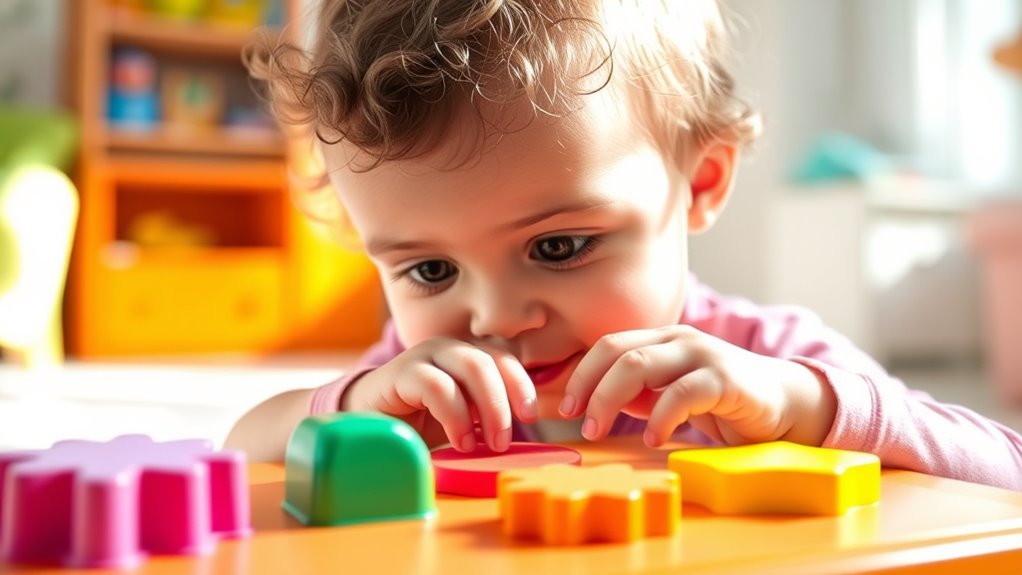
Simple puzzles and shape sorters are excellent tools for developing infants’ and toddlers’ hand-eye coordination, as they encourage children to match shapes, fit pieces into corresponding slots, and manipulate objects with purpose. These activities promote motor skill development by requiring precise movements and control. They also support cognitive improvement as children learn to recognize shapes and problem-solve. To maximize benefits, consider these strategies:
- Use a variety of shapes and colors to stimulate visual recognition.
- Encourage children to complete puzzles independently to build confidence.
- Introduce new challenges gradually to enhance fine motor skills and cognitive growth.
Incorporating these tools into playtime helps children develop essential coordination skills while fostering their understanding of spatial relationships and shapes.
Tossing Soft Balls
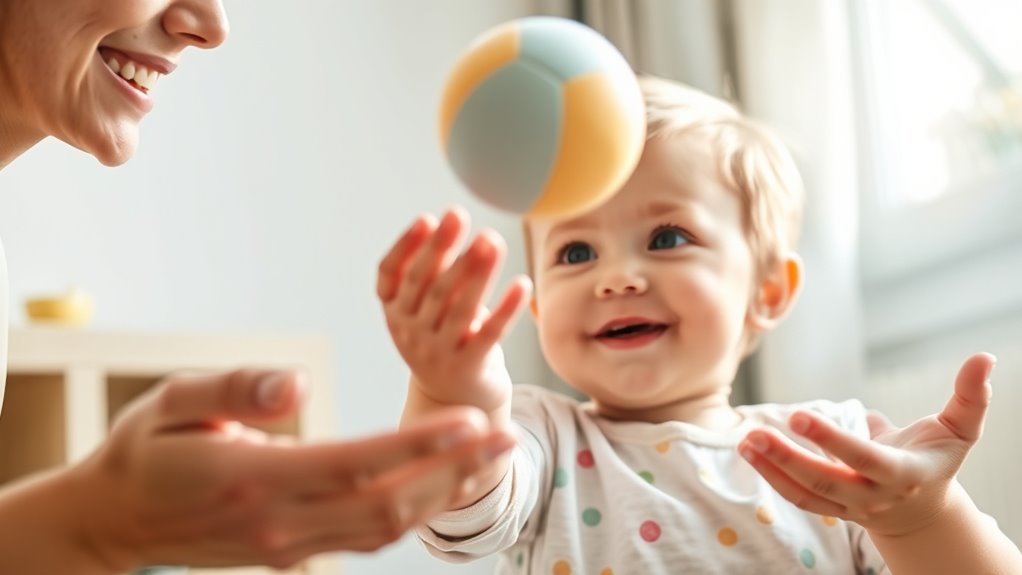
Tossing soft balls is an excellent activity for helping infants and toddlers develop their hand-eye coordination. When you encourage your little one to toss a soft ball gently, they learn to judge distance and improve their aim. You can add fun by bouncing the ball lightly on the ground before catching or soft tossing it back to them, which enhances their timing and coordination. As they practice catching and throwing, they’ll start to understand how their movements influence the ball’s trajectory. Keep the activity playful and simple, using lightweight, soft balls that are easy to grip. This game not only boosts their motor skills but also builds confidence in their ability to control objects. Overall, ball bouncing and soft tossing make engaging, developmental play for your toddler.
Playing With Pull-Back Cars
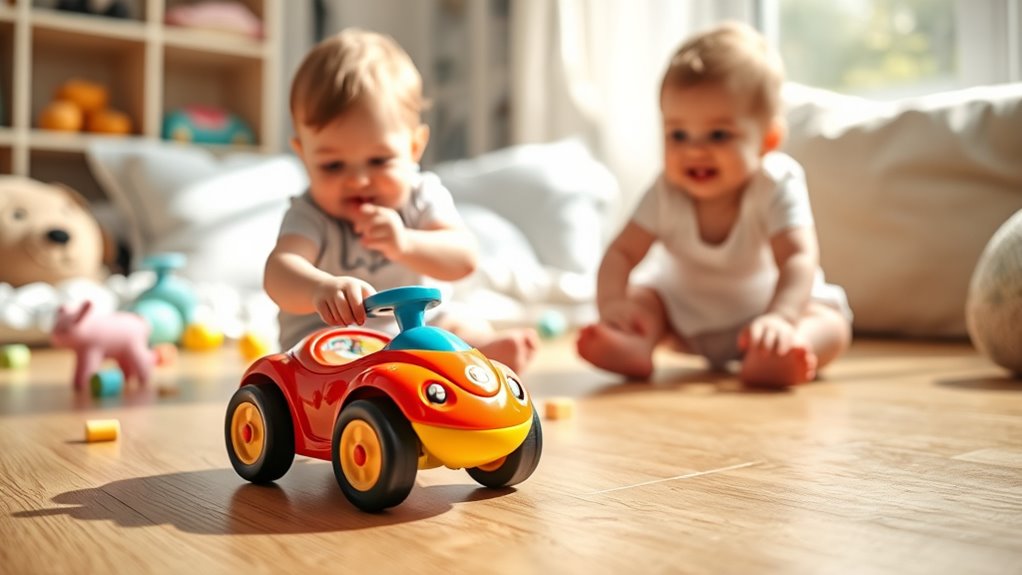
Playing with pull-back cars encourages infants and toddlers to practice their hand-eye coordination as they learn to control and release the vehicles. This activity helps develop fine motor skills by requiring precise grasping and releasing motions. As they push the cars back and watch them speed away, their cognitive development advances through understanding cause and effect. To maximize learning, consider these tips:
- Encourage repeated play to strengthen motor skills and build confidence.
- Use different-sized cars to challenge hand-eye coordination and promote problem-solving.
- Incorporate storytelling to boost cognitive development and engage their imagination.
Stringing Beads and Lacing Toys
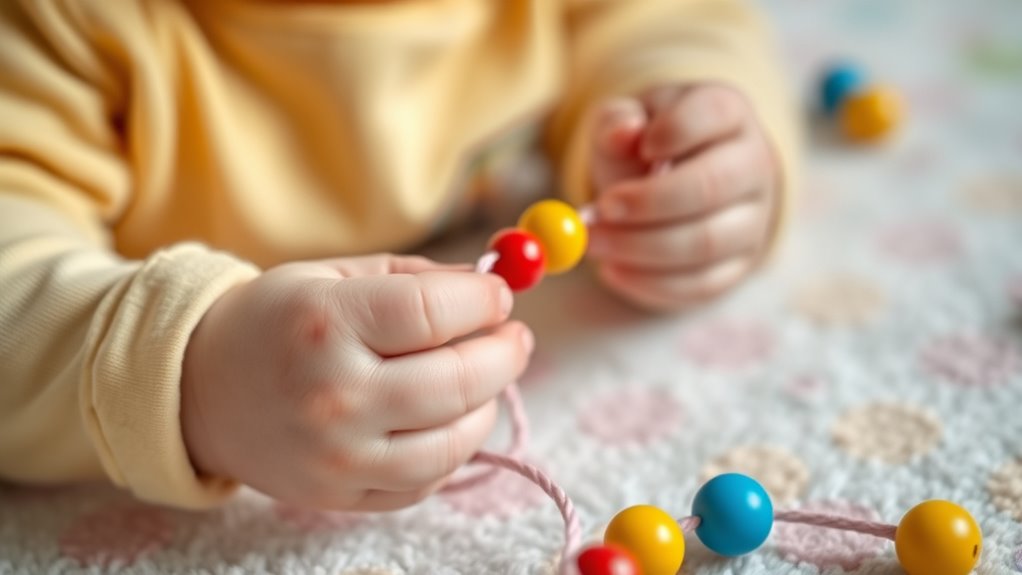
Stringing beads and lacing toys effectively enhance infants and toddlers’ hand-eye coordination by encouraging precise grasping and threading movements. These activities develop fine motor skills as children learn to pick up small beads or lace through tiny holes. As they practice, their finger strength and dexterity improve, laying the foundation for more complex tasks like writing. Additionally, stringing beads and lacing toys support cognitive development by helping children understand sequences, patterns, and spatial relationships. They learn to focus, coordinate their hand movements with their visual input, and plan their actions. These activities also foster patience and concentration, essential skills for future learning. Overall, they are simple yet powerful tools to boost both hand-eye coordination and mental growth in young children.
Pinning and Clipping Activities
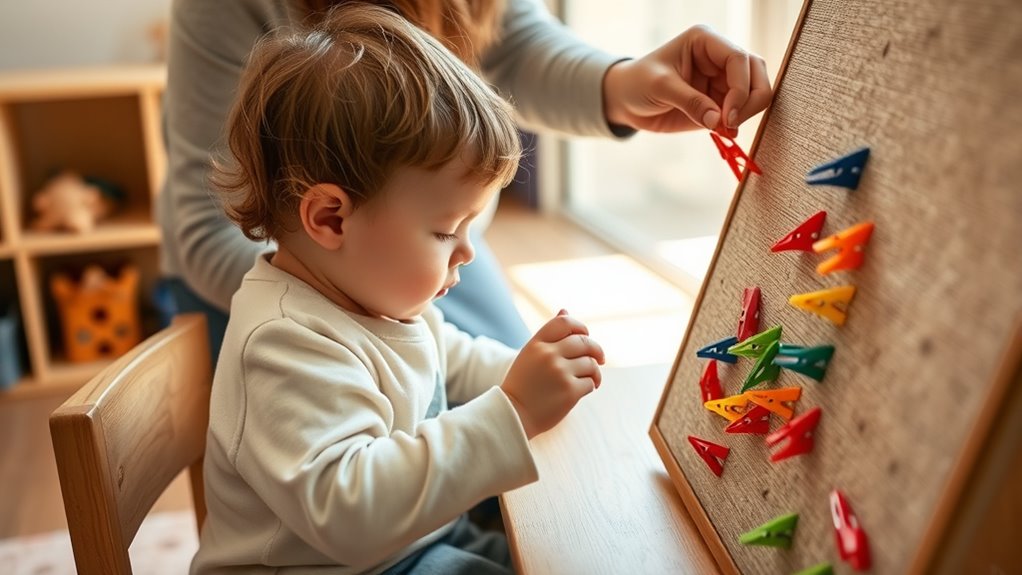
Pinning and clipping activities are excellent ways to develop infants’ and toddlers’ hand-eye coordination by requiring precise finger movements and visual focus. These activities enhance visual motor integration and strengthen eye-hand coordination, essential skills for everyday tasks. To maximize their benefits, consider these approaches:
- Use large, colorful clothespins or clips to encourage gripping and pinning onto a line or fabric.
- Incorporate activities like attaching cards or shapes to a string or board, promoting focused visual tracking.
- Gradually increase difficulty with smaller clips or more complex arrangements to challenge their fine motor precision.
Engaging in these activities helps your child refine their finger control and improves their ability to coordinate their visual focus with hand movements, laying a solid foundation for more complex tasks.
Sensory Bins and Texture Exploration
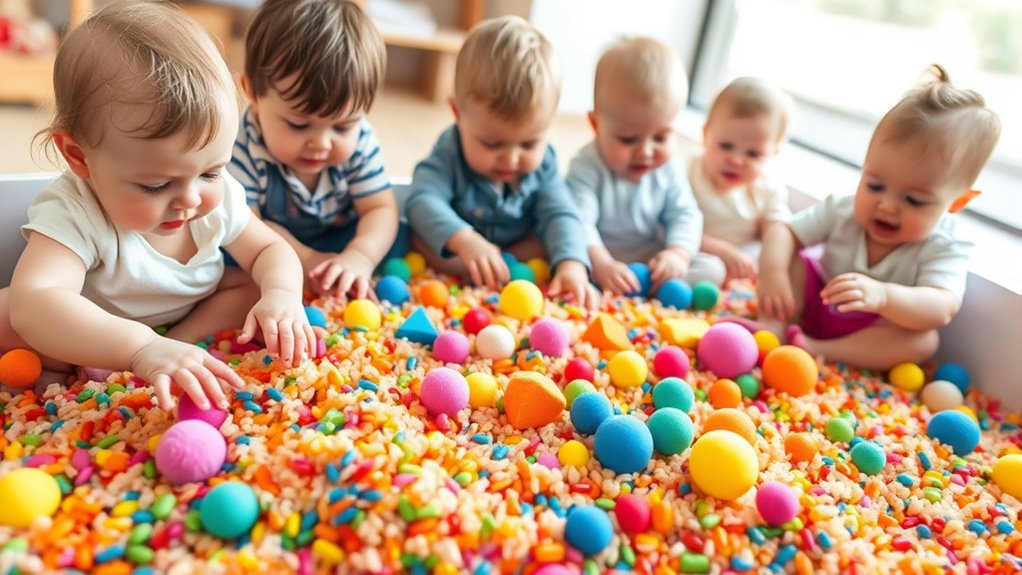
Sensory bins and texture exploration offer engaging ways for infants and toddlers to develop their hand-eye coordination through tactile experiences. By reaching into sensory bins filled with various materials like rice, beans, or pasta, you encourage your child to grasp, scoop, and manipulate objects. These activities refine fine motor skills and enhance spatial awareness. Encourage your little one to explore different textures—soft, rough, smooth, or squishy—to stimulate their sensory development. As they pick up, transfer, and sort items, they’re practicing precise hand movements while visually tracking their actions. Sensory bins provide a safe, mess-friendly environment where your child can experiment freely. Incorporating texture exploration into play helps strengthen hand-eye coordination and promotes curiosity, making learning both fun and beneficial.
Frequently Asked Questions
How Do Hand-Eye Coordination Skills Develop in Infants?
You might notice that as an infant grows, their hand-eye coordination develops through activities like visual tracking and fine motor skills. They begin by focusing on objects, improving their ability to follow movement with their eyes. As they practice reaching and grasping, their hand-eye coordination strengthens. These skills build gradually, helping your little one explore their environment more effectively and prepare for future tasks like writing and drawing.
What Safety Precautions Are Recommended During These Activities?
You should always prioritize safety during hand-eye coordination activities by implementing childproofing measures around the play area. Keep small objects out of reach to prevent choking, and guarantee the environment is free of sharp edges or hazards. Follow supervision guidelines closely, watching your child at all times. This way, you create a safe space where your little one can develop skills confidently without unnecessary risks.
How Can Caregivers Encourage Engagement in These Games?
Did you know that engaging activities boost your child’s development by up to 25%? To encourage participation, introduce appealing interactive toys and sensory activities that captivate their attention. Get down to their level, use enthusiastic voices, and make the games fun. Offer praise and gentle guidance to motivate them. By creating a lively, supportive environment, you’ll inspire your little one to explore and improve their hand-eye coordination naturally.
Are There Age-Specific Variations for These Activities?
You should consider age-specific adaptations to match your child’s developmental variations. For younger infants, use simple, slow-moving objects to stimulate their senses, while older toddlers benefit from more challenging activities like stacking blocks or catching balls. Tailoring activities to their age guarantees they stay engaged and develop skills at an appropriate pace. Observe their responses and adjust the difficulty to support growth without causing frustration or boredom.
How Do These Games Support Overall Developmental Milestones?
Think of these games as the blueprint for your child’s building blocks of development. They boost visual tracking skills, helping your child focus and follow moving objects, and fine motor skills, strengthening tiny muscles needed for writing and dressing. By engaging in these activities, you’re laying a solid foundation for future learning and coordination, supporting their growth as they explore and understand the world around them.
Conclusion
As you gently guide your little one through these engaging activities, you’re subtly nurturing their developing coordination skills. Each playful moment becomes a delicate step in their growth, fostering confidence and curiosity. By offering a variety of textures and challenges, you create a rich environment where their tiny hands and eyes learn to dance in harmony. Remember, these precious interactions are the quiet foundations of a lifetime of exploration and discovery.

